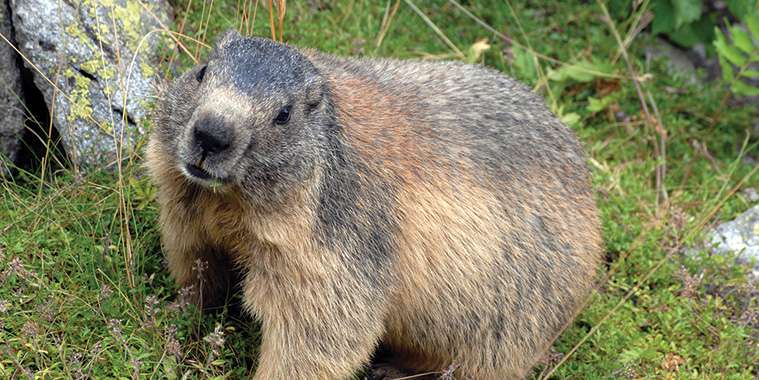By Dorothy Dobbie
Sunday, Feb. 2, was Groundhog Day. It may be that some people are wondering what a ground hog is. After all, we don’t see many hanging around our back yards these days.
This cuddly looking little animal is also called a woodchuck, not that it actually chucks wood. Its name is said to be derived from their Algonquin name, wuchak. It also earns the name whistle-pig for the fact that it sends out a bird-like whistle to warn of danger. In some places, it is called a land-beaver because that is what it resembles, minus the flat tail and with white teeth. Even so, it is no relation to that rodent. The groundhog is actually related to the squirrel and is a member of the family Sciuridae.
Groundhogs can climb trees, just like their squirrel cousins, and that’s a good thing because they have many enemies. Everything from foxes and coyotes to eagles and owls are on the lookout for groundhogs for a tasty and filling dinner — they can weigh as much as 15 pounds when they are ready to hibernate. And hibernate they do, sleeping profoundly until they awake — usually in early February! In hibernation, their metabolism slows down almost to a stop with heart beats reducing from 80 beats per minute to five and breaths from 16 to two. Body temperature drops to just above freezing — around 3° C!
To get through winter, they eat as much as a pound per sitting all summer, putting on lots of nutritious fat. They lose half that weight over winter. They are 16 to 20 inches long with a four to seven inch tail and average 10 to 15 pounds. Their long incisors grow about 1/16 inch a week in summer. They have long, curved claws to help in digging burrows. The burrows can be as much as 24 feet in length with some side passages. Their burrows are quite wide and contain several chambers: one for sleeping, one for nursing, one for the toilet and one for turning around. They also have at least two entrances.
Groundhogs are hasty breeders and brooders, having brief encounters as soon as they emerge from their winter burrows. Pregnancy lasts only one month and results in a litter of two to six blind, hairless chucklings, as they are sometimes called. They mature enough in about three months, heading off to dig their own burrows, but don’t become sexually mature until they are two. Just as in some other species, about 35 percent of females stay with Mom for up to a year, usually leaving just before the next littler arrives.
Their lifespan in the wild can be brief – three to six years, although they have been known to last 14 years in captivity.
Groundhogs can often be seen on their hind legs greeting each other in an almost human way, “kissing” by rubbing a nose against the mouth of the one being greeted.
These animals are susceptible to a type of hepatitis B virus that seems to be a precursor to liver cancer. They are being studied to learn more about the disease in humans.
However, as endearing as they can be, they can be a real pest in the garden. They have a varied diet feeding on grasses, clover, alfalfa, snails, grasshoppers, grubs, berries and hackberry, maple and mulberry leaves. They also enjoy corn, carrots and lettuce, meaning that they are not welcome guests in the vegetable patch.
There are all kinds of mean ways to get rid of groundhogs. Here are five from the Internet:
1. Catch it in a trap then release it in a wooded area five miles away from your home.
2. Create vibrations in the ground to scare them away. (I am not sure how you do this!)
3. Smoke them, drown them, poison them in their tunnels.
4. Pour ammonia down their tunnel, burn their feet with agricultural lime.
5. Deter with garlic and pepper, human hair, talcum powder.
6. Shoot them and eat them!
I’d be surprised if any of these but the last one works. For me, the answer is simple. Plant something they don’t like and enjoy watching their antics.
Dorothy Dobbie is the publisher of Manitoba Gardener.



